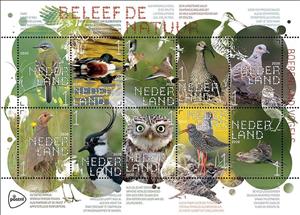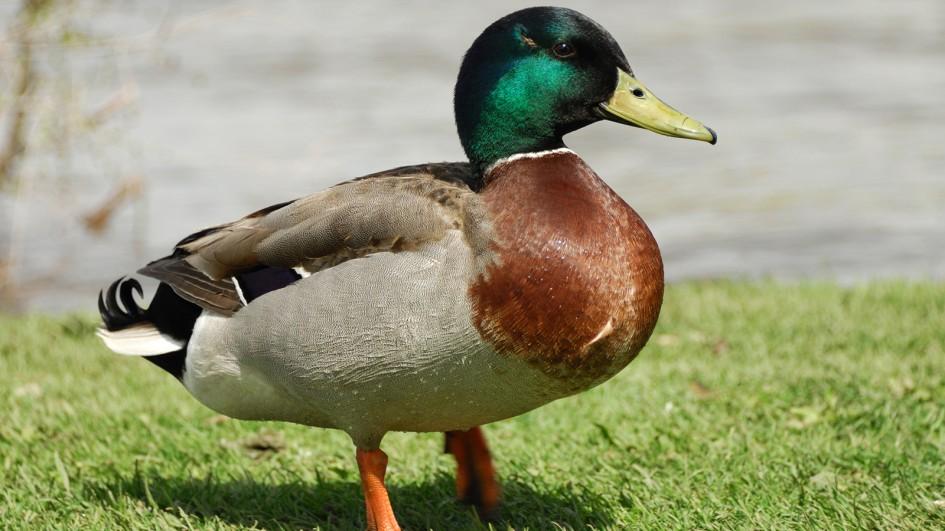Mini Sheet: Experience Nature : Farmland Birds (Netherlands 2020)
Experience Nature : Farmland Birds (Netherlands 2020)
24 February (Netherlands ) within release Experience Nature : Farmland Birds (2020) goes into circulation Mini Sheet Experience Nature : Farmland Birds face value 10*1 No Face Value
| Mini Sheet Experience Nature : Farmland Birds in catalogues | |
|---|---|
| Michel: | Mi: NL 3897-3906KB |
| Yvert et Tellier: | Yt: NL 3831-3840 |
| NVPH: | NVP: NL v3824-3833 |
Mini Sheet is square format.
Face value € 0.91 per stamp on day of issueAlso in the issue Experience Nature : Farmland Birds (2020):
- Mini Sheet - Experience Nature : Farmland Birds face value 10*1;
- Stamp - Western Yellow Wagtail (Motacilla flava) face value 1;
- Stamp - Northern Shoveler (Spatula clypeata) face value 1;
- Stamp - Black-Tailed Godwit (Limosa limosa) face value 1;
- Stamp - Common Curlew (Numenius arquata) face value 1;
- Stamp - European Turtle Dove (Streptopelia turtur) face value 1;
- Stamp - Grey Partridge (Perdix perdix) face value 1;
- Stamp - Northern Lapwing (Vanellus vanellus) face value 1;
- Stamp - Little Owl (Athene vidalii) face value 1;
- Stamp - Common Redshank (Tringa totanus) face value 1;
- Stamp - Eurasian Skylark (Alauda arvensis) face value 1;
Mini Sheet Experience Nature : Farmland Birds it reflects the thematic directions:
Animals are multicellular, eukaryotic organisms of the kingdom Animalia (also called Metazoa). All animals are motile, meaning they can move spontaneously and independently, at some point in their lives. Their body plan eventually becomes fixed as they develop, although some undergo a process of metamorphosis later on in their lives. All animals are heterotrophs: they must ingest other organisms or their products for sustenance.
Birds (Aves), a subgroup of Reptiles, are the last living examples of Dinosaurs. They are a group of endothermic vertebrates, characterised by feathers, toothless beaked jaws, the laying of hard-shelled eggs, a high metabolic rate, a four-chambered heart, and a strong yet lightweight skeleton. Birds live worldwide and range in size from the 5 cm (2 in) bee hummingbird to the 2.75 m (9 ft) ostrich. They rank as the class of tetrapods with the most living species, at approximately ten thousand, with more than half of these being passerines, sometimes known as perching birds. Birds are the closest living relatives of crocodilians.
Birds of prey or predatory birds, also known as raptors, are hypercarnivorous bird species that actively hunt and feed on other vertebrates (mainly mammals, reptiles and smaller birds). In addition to speed and strength, these predators have keen eyesight for detecting prey from a distance or during flight, strong feet with sharp talons for grasping or killing prey, and powerful, curved beaks for tearing off flesh. Although predatory birds primarily hunt live prey, many species (such as fish eagles, vultures and condors) also scavenge and eat carrion
Duck is the common name for numerous species of waterfowl in the family Anatidae. Ducks are generally smaller and shorter-necked than swans and geese, which are members of the same family. Divided among several subfamilies, they are a form taxon; they do not represent a monophyletic group (the group of all descendants of a single common ancestral species), since swans and geese are not considered ducks. Ducks are mostly aquatic birds, and may be found in both fresh water and sea wate
Owls are birds from the order Strigiformes, which includes over 200 species of mostly solitary and nocturnal birds of prey typified by an upright stance, a large, broad head, binocular vision, binaural hearing, sharp talons, and feathers adapted for silent flight. Exceptions include the diurnal northern hawk-owl and the gregarious burrowing owl.
Columbidae (/kəˈlʌmbɪdiː/ kə-LUM-bih-dee) is a bird family consisting of doves and pigeons. It is the only family in the order Columbiformes. These are stout-bodied birds with short necks and short slender bills that in some species feature fleshy ceres. They primarily feed on plants, and can be taxonomically divided amongst granivores, that feed mostly on the ground on seeds, and frugivores, that feed mostly on fruits, from branches. The family occurs worldwide, often in close proximity with humans, but the greatest variety is in the Indomalayan and Australasian realms.






